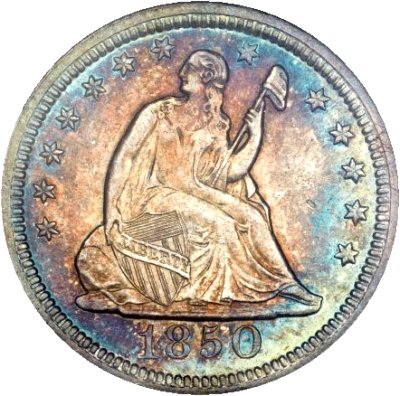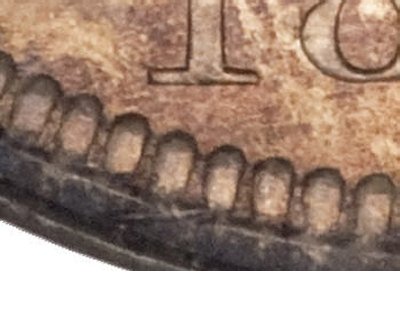

|
|
|
1850 Liberty Seated Quarter Dollar - 1 Digit on Obverse Rim
by Greg Johnson
Liberty Seated coinage, particularly in the early
years of the design, has a large number of misplaced dates. In fact, there are
so many, and in so many different places – denticles, rock, gown, shield
– that one almost has to wonder what was going on. Those of us who study
die varieties might not even be surprised to find a date on Miss Liberty’s
face or in the obverse fields. While confessing great ignorance as to just how
the date punch was positioned in order to add the date to the working die, I
also have to admit that I have wondered if some of the mint employees of the
time were blind, drunk, or both. How many times did they miss the die entirely?
Was there a bench somewhere at the mint with dates of various sizes punched
into its surface? Perhaps employees, in scenes reminiscent of the The Three
Stooges, had dates accidently punched into various body parts?
It’s easy to be critical from a distance of 170 years and I am certain
that positioning the date on the dies was far more difficult than we imagine
based on our personal experiences in 2012. And, that difficulty gives us much
interesting numismatic material to study. One of the most interesting, and arguably
the most extreme misplaced dates in the Liberty Seated Quarter series is the
1850 quarter with the base of a one on the rim. It appears the punch did, in
fact, very nearly miss the die entirely as the date was being applied.
One notable feature of the 1850 “1 on rim” quarter, is that it is
difficult or impossible to attribute in low grades. The rim, being the highest
point of the design, wears away first, tending to obliterate the “1”
on most coins grading below XF. The 2007 LSCC survey indicated that 1850 quarters
without the extra digit outnumbered those with by a count of 26 to 17. As expected,
only 2 coins with the extra 1 were reported in grades from AG – VF, whereas
there were 17 coins in that grade range without the 1. The grades XF and above,
in contrast, featured 15 coins with the extra digit, and only 9 (including two
proofs) without. Though partly speculation, I tend to believe that somewhat
more than half of 1850 quarters are the variety with the extra 1; but the two
obverse dies that have been identified are too similar to prove that with coins
grading below around VF 30 by today’s standards.


The 1850, as a date, is scarce and pretty well
known by collectors as a better date in the series. Its rarity increases with
grade to the point that it was considered to be R7 (4-12 known) in mint state
by Briggs in 1991. Though the past twenty years have seen additional examples
come to market and, arguably, a loosening in the definition of mint state, the
issue remains about R6- in mint state (estimated 25-30 examples). Amongst mint
state Philadelphia quarters certified at PCGS the 1850 ranks fourth (behind
the 1848, 1869, and 1842) with 14 “grading events” for mint state
coins.
References
The Comprehensive Encyclopedia of United States Liberty Seated Quarters, Larry
Briggs (Lima, OH 1991)
Gobrecht Journal Issue #102
Photos Courtesy of Heritage Archives